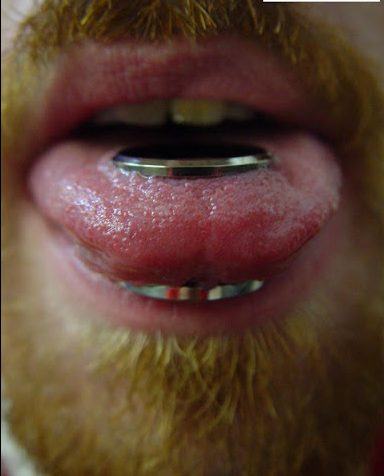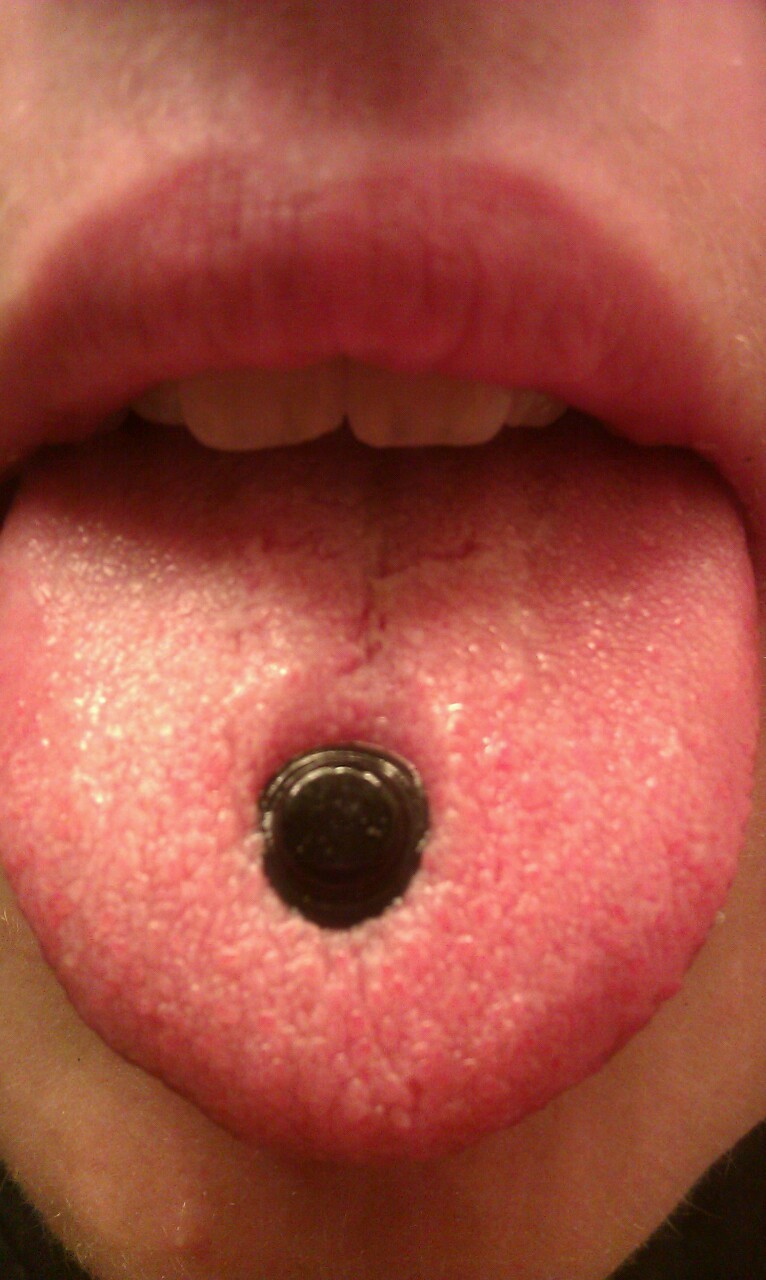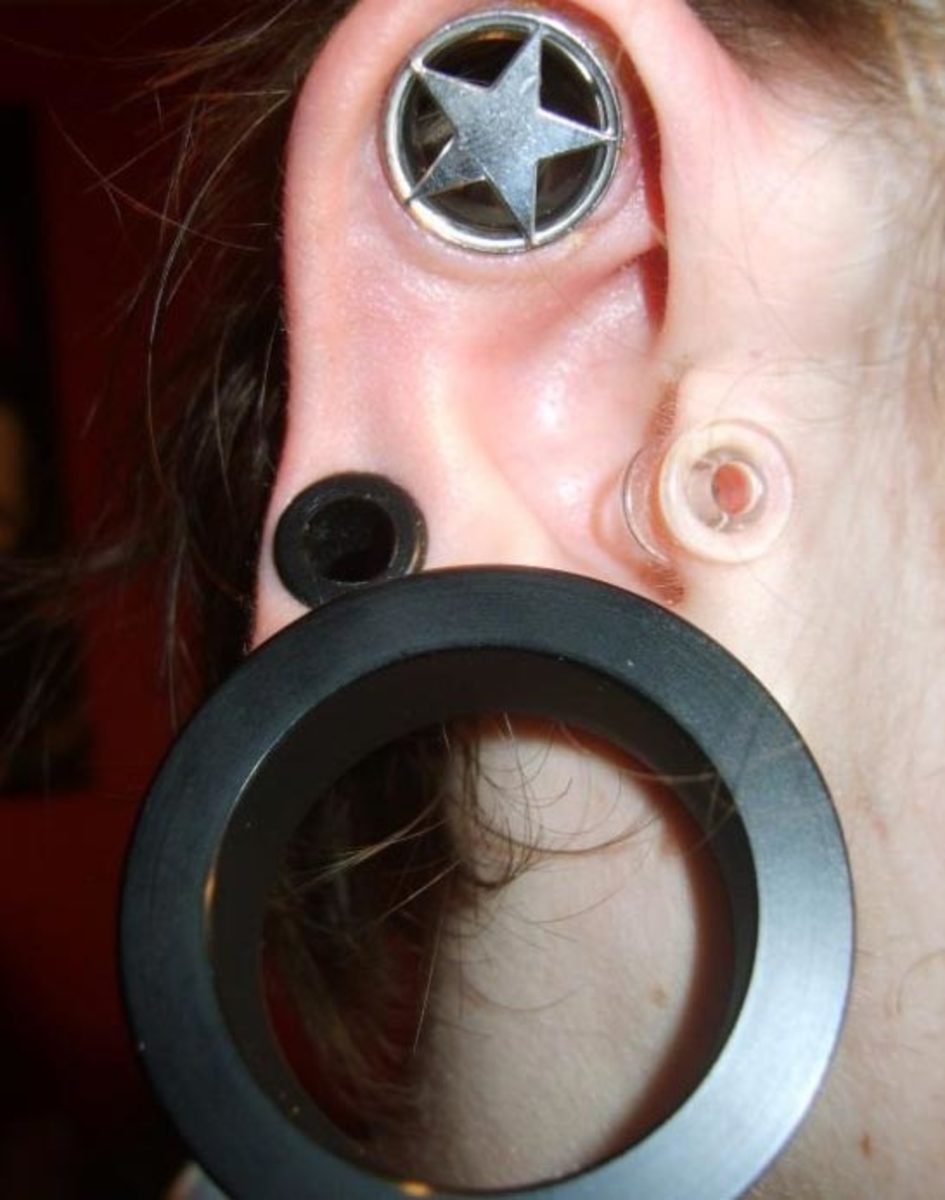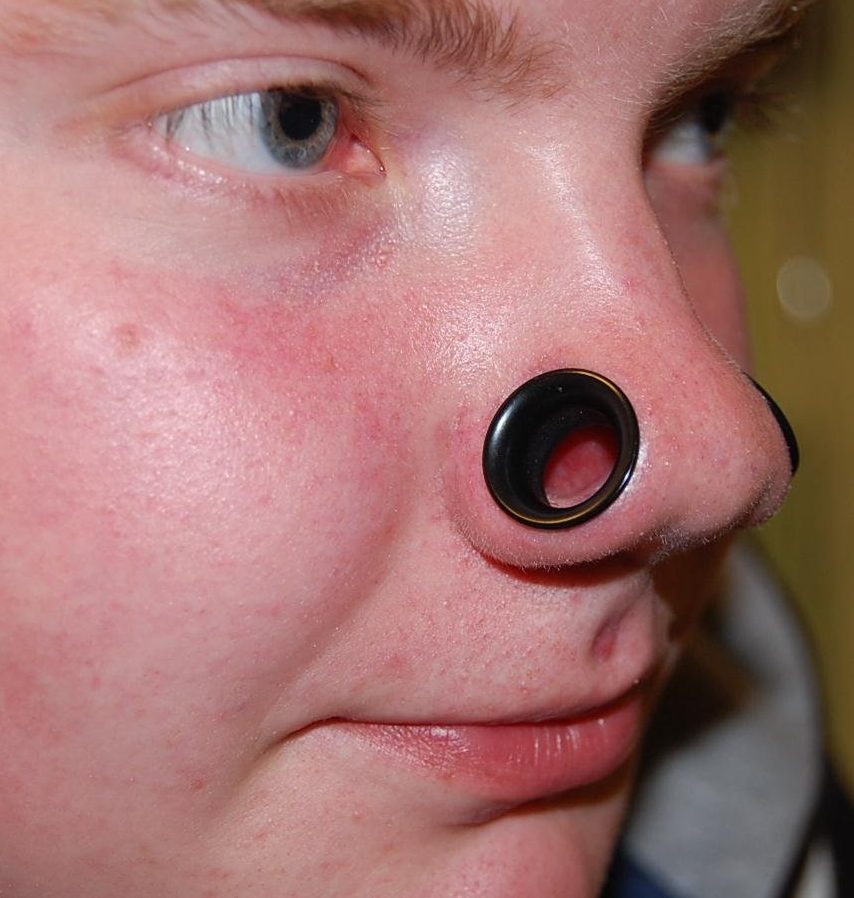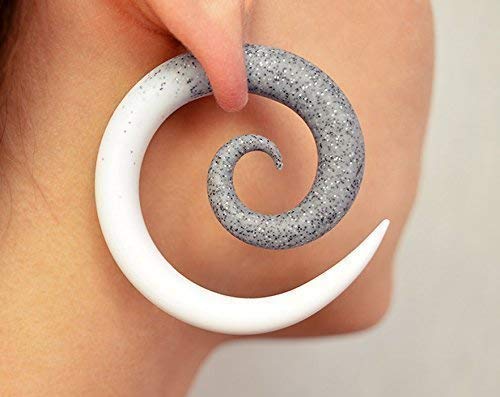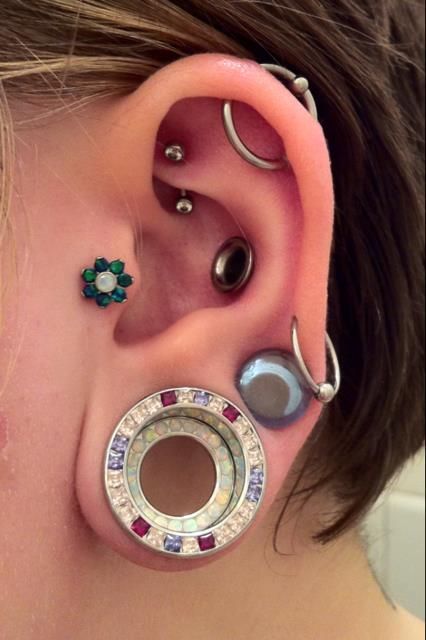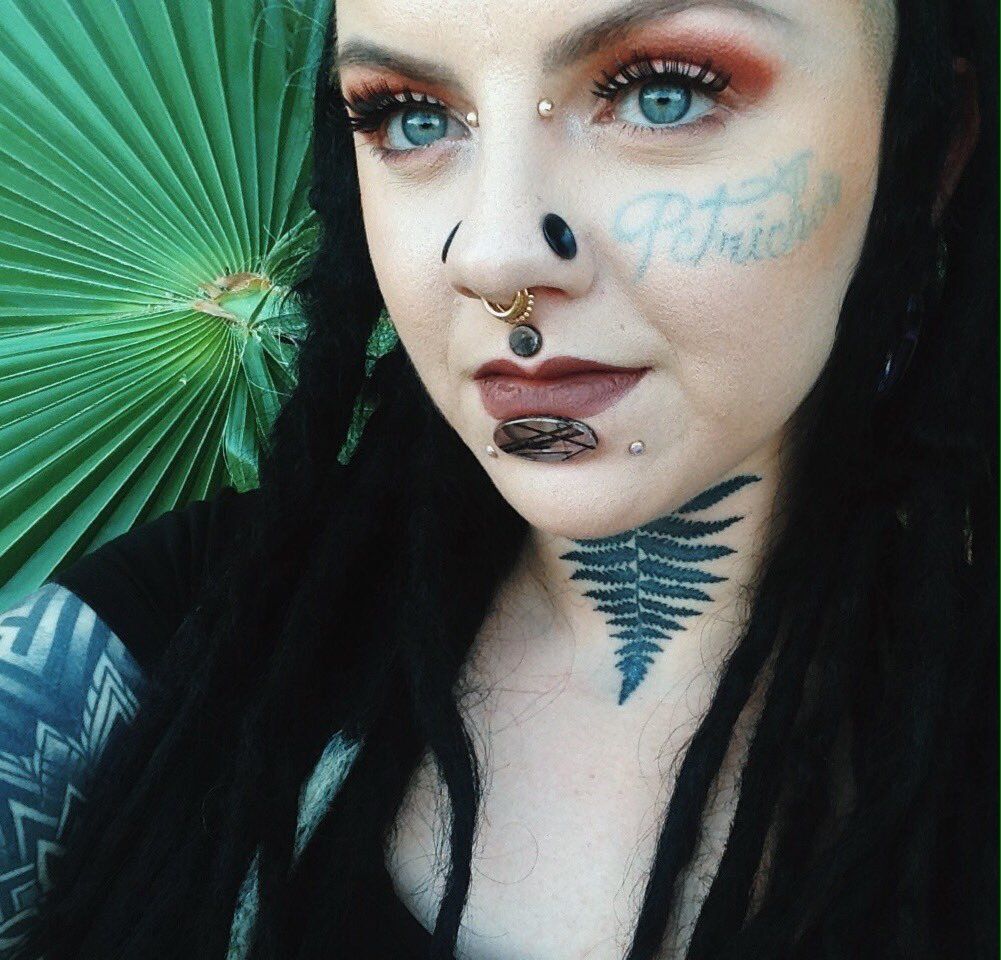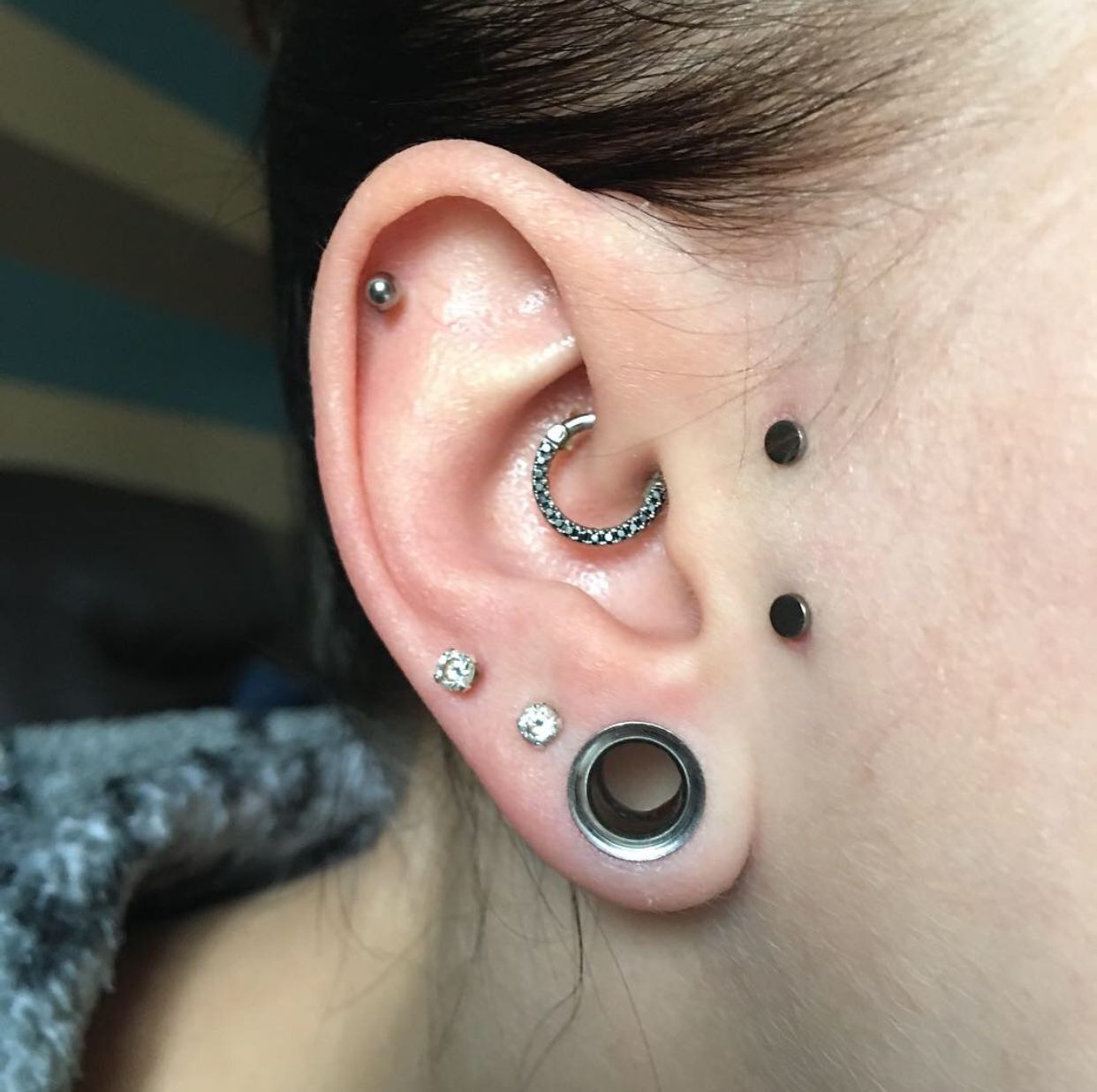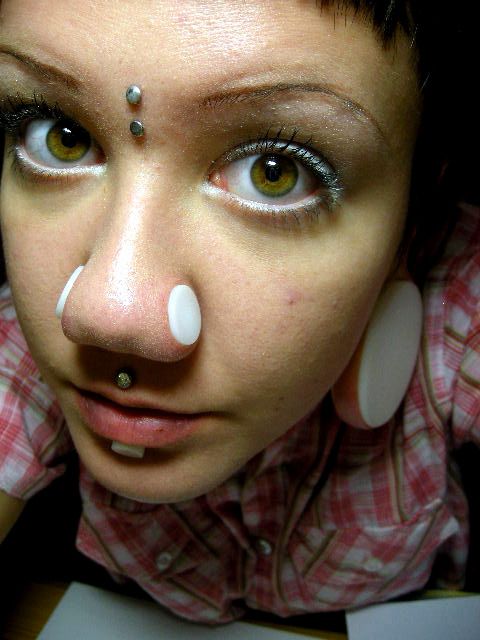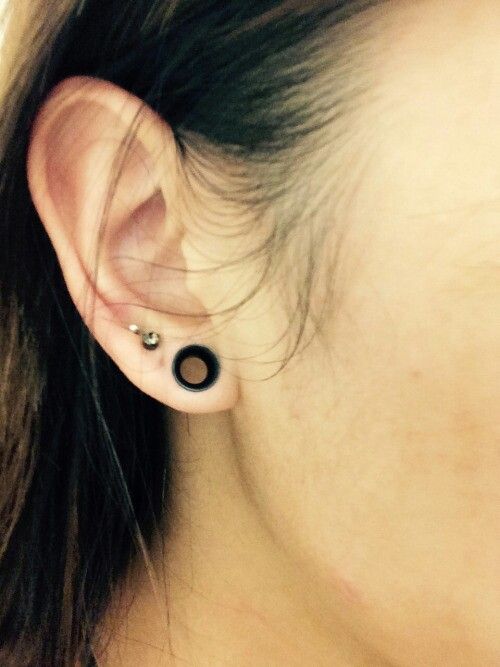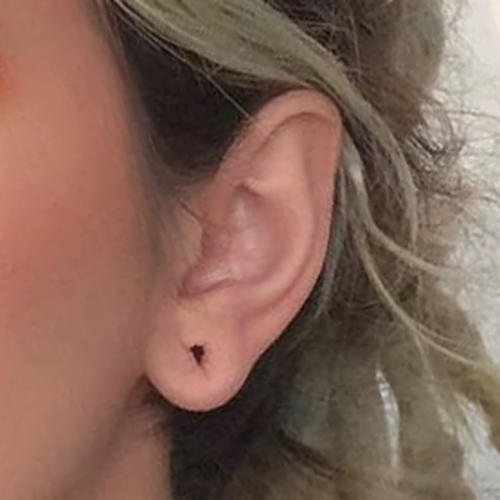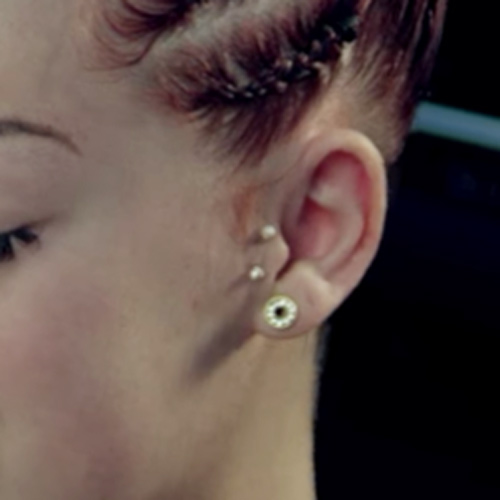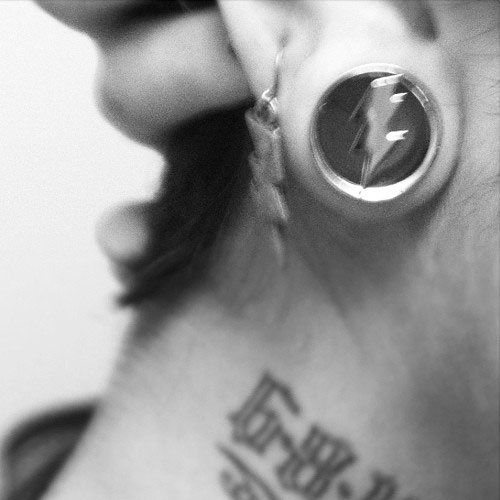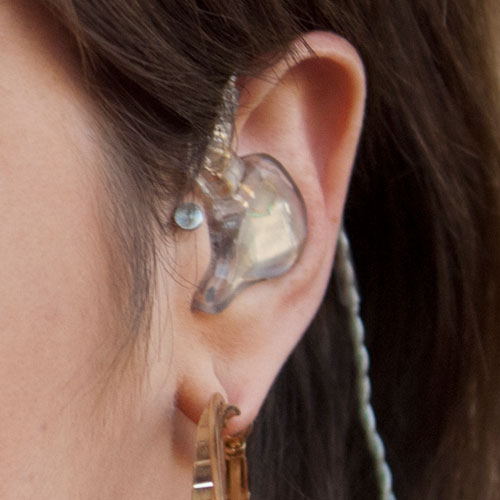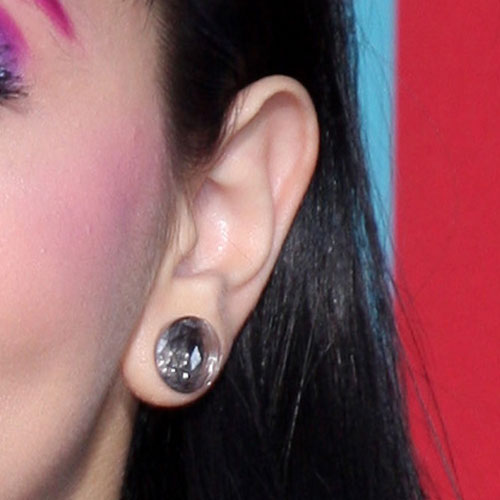The process of stretching in the context of body piercing is a process in which the healed piercing is stretched so that it can be added with some specific kind of jewelry. Ears are the most pierced kind of jewelry along with others like septum piercing, tongue piercing, and lip piercing, and even lip plates. While all kinds of piercing can be stretched to some point, the piercing that is made on cartilage takes more time to get stretched and are also more likely to form scars if it is not stretched adequately. Dermal punching is the most preferred kind of stretched piercing in the cartilage piercing category.
The process of stretching is done in a small amount so that it can reduce the potential for damage to the healed piercing or create scars. In the United Nations, most stretched piercing, no matter where go up by a single even-sized gauge increment at the same time. The point of no return or the maximum size is 8 mm or 0 g. A hole that would be larger than this would be not close to standard piercing size. Since each body is different and any kind of piercing, no matter stretched or not should be looked at as a permanent feature in body modification. In the rest of the world, especially Europe the jewelry size is metric but the increment between the standard size is quite the same.
The first official use of stretched earrings can be dated back to the culture in Ancient Egypt where the sarcophagus of the Pharaoh Tutankhamun was pierced. The other origin story was said to be the use of an ear gauge which began in sub-Saharan Africa. We will read more about the gauged or stretched piercing in the following article.
Contents (Click to Jump)
Even though it is a very eccentric thing, but the youth of today not only just get pierced but they also like to stretch their piercings. Even if you have a piercing that was pierced to a smaller size which could be 20 gauge, 18 gauge, and even 16 gauge, you can still go ahead and get them stretched to a larger size. But what is more, is that it does not matter how recently you have had them pierced. You can go ahead and stretch your piercings from 10 years ago now too.
It takes a lot of time for your earrings to stretch properly as you would want to give your ears some rest after you have stretched it a bit. If you stretch it too quickly, it can cause some major complications. You can even stretch any kind of piercing but the most common piercing that is stretched is called lobe piercing. Other common stretched piercings include inner conch, septum, nose, belly button, tongue, and even ear.
Otzi the Iceman
Otzi is the earliest documented rudimentary mummy to have had stretched ears. It is determined that Otzi was living some time nearby 3300 B.C.! His ears had been expanded to around 11mm.
Gauges in African Culture
Many tribes in Africa have implemented the practice of gauging and stretching in the areas especially lips and earls. The women who belonged to the Mursi tribe, for instance, had their lips cut open at wider angles at a very young age. Once you cut it open, the women began the stretching process. When the holes come into a definitive size, the insert clay or wooden plates into the stretched area. The stretched earlobes or lips are a symbol of womanly strength and beauty.
Ear gauging or stretching has been a common practice among the Masai tribes in Africa where both men and women participated in these rituals. They wore jewelry made up of ivory, wood, thorns in their stretched ears which shows beauty, strength, and even connection with spirituality.
The women who belonged to the Fulani tribe also had a very unique Ear gauging or stretching process with golden gauges. The size of the piercings, however, was smaller than the other tribes. The size and shape of the jewelry are what make them different from other tribes. These kinds of earrings have a golden pendant center which has a hoop to attach it to the ears.
Ear Stretching in Central America
Central American tribes such as the Aztecs and Mayans of Mexico were popular for their large earplugs or flesh tunnels which were symbolic of wealth and good social status. The Mayan tribe usually used jade as their preferred element of choice whereas the Aztec tribe used gold, silver, and copper for their Ear gauging or stretching.
Gauging Throughout Asia
Tribes in Thailand, such as the Lahu, use the process of stretching their earlobes with large portions of jewelry. Other examples of Ear gauging or stretching can be found all over the Asian continent with countries like Japan, Myanmar, and India. Many people also believed that the creator of Buddhism, Gautama Buddha had gauged earlobes too. This was because of wearing heavy jewelry in the early stages of his life which was depicted by wealth.
Ancient Body Gauging in Ancient Egypt
King Tut is a great instance of Egyptian ear stretching. This Egyptian Pharaoh started his reign in 1332 B.C. The golden mask of his Sarcophagus shows the stretched holes in his ears. The legends have it that the young people of Ancient Egypt had Ear gauging or stretching until they reached full maturity. King Tut died at a very early age which is why he had huge ear gauges.
Septum Gauges in History
The septum which can be described with the flesh between the two nostrils has been pierced and stretched throughout the various cultures all over the world. This practice was quite common in Native American shamans, tribals hunters, people who performed rituals, and leaders. It was a symbol to represent leadership qualities and a connection with the spiritual world.
If you decide to get yourself stretched or gauged piercing, you will have to wait until your initial piercings have fully healed. It is recommended that you give your piercing at least 6 to 12 months of healing time before the stretched or gauged piercing process. Once you are assured that your ear is finally healed, you can begin your first stretch. Usually, the earlobes that are pierced are somewhere between 20 gauge to 8 gauge. The larger will be the number, the smaller is the jewelry size and vice versa. So, for example, a 16 gauge punch is quite small as the thickness of nails but a 0 gauge stretched or gauged piercing is as thick as a pencil eraser. The gauge size dimensions of jewelry normally go by twos – 20g, 18g, 16g, 14g, 12g, etc.
To get yourself a stretched or gauged piercing, you need to start slow which includes stretching step by step gradually, like, from moving 18 g to 16 g. To do this yourself, you can use a taper which is too for stretching that is thinner on one side and larger on the other. This will increase the gauge size. You can use the plug or tunnel with taper for the most comfortable experience which is usually recommended by everyone else. The plug or tunnel will be attached to the larger part of the taper which will let you have a smoother transition. The taper is usually meant to be a stretching tool and should not be worn every day. If you are uncomfortable getting a stretched or gauged piercing on your own, you can take the help of a professional.
However, no matter what you choose, you need to wait in between the stretched for a substantial amount of time. By substantial, we mean a month or more in between each stretch. This will give your piercing time to fully heal before you move on to the next stretch. Your piercing must be completely okay which means that there should be no redness, inflammation, crust formation, or any liquid oozing from your piercing.
During the stretched or gauged piercing, if your piercing starts to bleed, or your skin turns while in color or is so painful that you cant continue, remove the taper or any kind of jewelry immediately. It is a sign that your stretched or gauged piercing is not ready for any further stretched or you are probably applying more force than usual. Thus you will need more time to let your piercing heal completely before you try to stretch it even further. If you force a stretch, it can cause certain problems, like a blowout, or your skin can even tear.
A blowout is when the skin on the inside of the stretched or gauged piercing begins to come to the outer side of the piercing which gives it a very thick and unappealing appearance. It can only happen on either the front or the back part of the ears. Sometimes if you suffer from serious blowouts, you can only get it right with surgery.
Usually, lobes are pierced with a 20, 18, or 16 gauge, but it will normally rely on where you go to get your stretched or gauged piercing done from. Some people, for example, pierce with piercing guns, so the measure of the piercing will be the measure of the jewelry that you want to begin with, which is a 20 gauge.
As for other kinds of piercings, most of the time, you will discover that they are pierced with 14-gauge piercings. Cartilage, nose, septum, navel, etc, are all usually punched at a 14 gauge. Common gauge measurements are listed in even numbers resting towards 00 g, with the size of the gauge rising as the amount declines. For instance, a 10-gauge piercing is more petite than a 2-gauge piercing. For areas greater than 00, the gauges are designated by fractions.
Besides anything out of the way that you would like for your stretched or gauged piercing, the piercers have a standard size that they would prefer to use for starting the stretched or gauged piercing. It also depends greatly on the location of the jewelry If you can’t get yourself to a local piercing studio to determine the gauge size perfect for you, there is much equipment available online. For instance, you can use a gauge wheel which is a flat disk that has some slides cut into it that will correspond with a particular gauge size. You just need to slide your jewelry into these slides until you find the one that fits perfectly well. The size of the notch will be printed right on the wheel.
However, in any case, it is always best to consult a professional and ask your pricier about the gauge size if anything at all. No matter what option that you chose, it is always better to start with a larger gauge as the best option for body jewelry. A very small gauge like 18 g or 16 g is more prone to complications which will cause a lot of pain and even rejection or infection. But as long as it is pierced properly, a larger gauge that has the dimension of 14 g or 12 g will be even more stable.
Some people also have the fear that piercing with 12 g will hurt more than getting pierced with a 16 g and thus they avoid a larger gauge completely. However, it is important to know that it is now how it works. It will cause pain either way. It is also to be noted that you will have to keep the new stretched or gauged piercings in place for a few months so that you do not risk any complications and let it give ample time to heal properly.
No matter what, finding your perfect size for the gauge is extremely important and there are many reasons for it. It can be compared to the size of the shoe you wear. If you do not have the correct size, you will feel uncomfortable and it might hurt you too. With a wrong gauge size, you can risk having physical damage like scars and tears.
Jewelry that will be thin or smaller for your gauge could cause the stretched or gauged piercing to shrink back and might lead to tearing and cutting of piercing. On the other hand, if your jewelry is too thick, it might not go inside the hole smoothly and would even cause tearing, bleeding, and other kinds of problems.
Thus it is important to determine your perfect gauge size to avoid any trouble and get a smooth stretched or gauged piercing process done.
When you get a stretched or gauged piercing, chances are that they will not shrink back to their normal size. So when you decide to get a stretched or gauged piercing, make sure you are prepared for a lifetime commitment to get a permanent stretch. While it is not possible to get your ear back to its initial shape, some factors need to be taken into consideration while getting a stretched or gauged piercing:
- Size of Stretch: The higher you go with size, it is less likely that your piercing will get back to normal. Usually, a 0 g is known as the point of no return which means that once you have stretched this far, there is no going back to the normal position. When you get a 0 g piercing, you might experience a bit of shrinking but not back to the original position.
- Length of Stretch Time: If your piercing has been extended for several years or longer, it’s rather well established and apparently isn’t fitting to recoil back to perfectly standard size. Contracting to a level below gauge is feasible, though.
- How It Was Stretched: If the piercing was pulled too promptly, particularly if there was a resulting wound membrane, it apparently won’t return very quickly. If it was created with a scalpel or dermal punch, it surely won’t contract.
These are few factors that will let your piercing shrink or not but the amount of shrinkage will also depend on yourself and how your skin reacts to the stretched or gauged piercing. Everybody is different and the amount of shrink will depend on just that. But besides, everybody’s modification will be sort of permanent.
There are many various kinds of methods that can help you to stretch a piercing. Here are some of them:
- Tapering: This is one of the most common and safest methods used for stretching the soft tissues for stretched or gauged piercings such as ear lobes. For this method, a tapered surgical steel rod is inserted into the piercing with the smaller side of the rod going in first and the hole is slowly made bigger as the wider parts of the rod are gently pushed inside the hole. A piece of jewelry with a larger gauge is pushed in too so that the stretched or gauged piercing could stay in its new size. Tapering uses the employment of a taper, a conical rod specifically made particularly for this reason. It is lubricated and inserted through the fistula till the widest portion of the taper is in level with the skin around the piercing. A larger piece of jewelry is then pushed inside and made parallel to the back of the taper. It comes in several sizes and is distinctive because it has a gauge at the end. They can differ in length but most of them are 2 to 3 inches in size. Mist of the tapers that are used are made with stainless steel or acrylic and some even have threats coming from the wider end of it to let the attachment of the barbel jewelry to make insert easily. People can sometimes also improvise objects to use as tapers like knitting needles, porcupine quills, cocktail sticks for people who are tapering at home. This process is not recommended for professionals as one can’t really measure their gauge. Besides this, even sterile gauge practice is necessary and is hard to follow at home. Above the size of 2 g which is 6.5 mm or 0.26 inches, tapering is discouraged. The use of the taper makes it easy to stretch the hole if it is not healed completely which makes it prone t many complications like inflammation, bleeding, swelling, blowouts, etc. There are three kinds of tapers that you can choose to get :
- -Acrylic: These are some of the cheaper tapers and of course, one of the most famous amongst all. They are not easy to handle and work with but they are not the ideal choice if you can afford better equipment for you stretched or gauged piercing.
- -Steel: The steel tapers are a bit more expensive than the acrylic ones but they are more comfortable to handle and make for a great stretch or gauge. They can be easily sterilized which is a great advantage over acrylic tapers.
- -Concave Steel: They are mostly the same as steel tapers but it is different from it because the back of the equipment is concave and not flat. This might look pretty small but it makes a huge difference when itis time to remove the taper and add the plugs. The plug can be placed in a recessed area and can be pushed through very easily. The number of tapers that you will need would depend on the kind of stretch you want to do. If you are just looking to move from a 16 g to 14 g stretch, you will need one taper, which means, moving aside up. But if you want something more like from 16 g to 8 g, you will need multiple tapers, that is, moving 4 sizes up.
- -Titanium – Related to steel but lightweight and can decrease the possibility of irritation for people with delicate skin.
- -Silicone – A good element to withdraw any antagonistic effects, but silicone plugs get stained more quickly than the alternatives and require to be washed more frequently. These plugs are light and flexible, which allows the larger plug to fit in the fistula. Once it is folded to be inserted into the ear, they expand and stretch the ears. The process of stretching the ears with the fistula is quite dangerous and is not usually recommended to use silicone plugs to stretch because of the tacky surface, The stretched ear can only adhere to the silicone if the lubricant that has been used is pushed out by the pressure of the stretch so that it can be airtight which can tap infection and cause it to spread internally. This is also because silicone contracts and expands when there is a temperature change. It can swell and blow out the stretched skin.
- -Organic – This is a common kind that includes plugs made up of elements such as wood, stone, and glass. You will also require to make sure that you have single flare plugs for stretched or gauged piercings. Single flare plugs have a lip on simply one end to make it simpler to interpolate the plug after increasing. The lipless surface is then held in place with a rubber ring.
- Weights: This is not a prescribed process, as it does not stretch the piercing very evenly and can make the skin thin around the piercing which can cause sagging and drooping of the skin. The weights that are applied pull the ear down. You can also use heavy jewelry as a weight but it could only be worn for a shorter period of time if it can be worn at all. Big, chunky jewelry or weighted things can be practiced to stretch punches. This system is not generally accepted in the modern-day, as it can let the piercing cause migrate and can, particularly in ears, direct to a thinning of tissue that is damaging or needs reconstructive operation. Nevertheless, it is a process that has been traditionally employed by different societies, such as the Dayaks in Borneo, that use advanced earlobe elongation methods.
- Dermal Punch: This process punches off a hole through the skin by the punching process. The dermal punch is a method that is as traumatic as it sounds but many people choose it over tapering for stretching cartilage piercings as it has lesser blood flow and can be crushed beneath the weight of tapered stretch. The dermal punch is useful because it can be utilized to stretch different gauges at a single time but is suggested only for cartilage and not soft tissue. Just make sure that you are asking for a professional to make a dermal hole in your ear. It involves using a circular razor with the desired diameter is put against the skin. It is usually performed with the earlobe or the cartilage. The blade is then pushed down and twisted so that a small portion of the skin can be taken out. The reason is then pulled out and the jewelry is inserted, The jewelry is usually non-flared or single flared pyrex glass plug which is of the same size and diameter. This is useful if you aim to achieve large gauge cartilage piercings and is often not allowed for soft tissues which can be easily overstretched. It is also less painful and not that damaging to the tissue than using a hypodermic needle even if it has the same gauge.
- Dead stretching: Dead stretching is the process of gauged or stretched piercing which inserts large jewelry into an existing piercing without using any other equipment. Just like with tapering, this can cause to injure the fistula if it is not healed completely. It can cause tears or a blowout in which case the fistula would be pushed back. Some kinds of pairings will stretch slightly on their own and larger pieces of jewelry can be put inside without any complications, especially with the tongue piercing. You can even opt for self-stretching in other piercings by massaging the tissue, using the jewelry, and making small circles. Dead stretching is a kind of gauged or stretched piercing process that is relatively safe if the jewelry is lubricated from all the sides so that it can easily slip into the ear. The jewelry must not be forced. The septum piercing can be stretched to 0 g by using a combination of dead stretching and tapering.
- Teflon tape stretching: In this gauged or stretched piercing process, the existing jewelry is first removed and a thin layer of non-adhesive Teflon tape or PFTE tape is wrapped around it. This tape is safe for gauged or stretched piercing. Non-adhesive tape and heat shrink tubing are also used in many cases. The jewelry is then put back again and piercing starts to adapt to a new measurement as the process is repeated with thicker layers of tape in the process. The tape is not an essential product for people who want to get gauged or stretched piercing done. The tape helps you to take the high gauge plug and add a bit of width to it by wrapping the tape around the piercing. By increasing the thickness of the tape, one can stretch the ears beyond the size of the plug. Tapings the plug might not be as effective as other methods and it is only utilized by people who want to go awry from the standard gauge widths that are when you can find the special equipment thick enough to continue stretching your piercing. For most people, sticking to the tapers would be enough but if you use the tape, you need to find the one that fits on your ears and is used smoothly. Polytetrafluoroethylene (PTFE) tape is usually suggested. If you have ever done or seen the plumbing work, you know that this is the tape that is used to seal threads. It is thin and very narrow which is thus quite simple to use and wrap. Bondage tape is another kind of tape that is used for gauged or stretched piercing. Just like PTFE tape, this tape is thin and adheres well. It is also self-adhering which means that it sticks to itself and does not have to rely on the sticky side.
- Scalpelling: Rather than gauging or stretching a healed fistula, this process is useful for expanding the size of the piercing by using a scalpel which allows you to cit the edge of the fistula to expand the diameter. It is often used in earlobe piercing. It is a great technique that is also used to change the placement of some larger piercing by combining two existing piercings into a single one or by making a higher gauge piercing when the scar tissue is not letting the stretch occur or when the tissue has thinned so much that it will make it complicated for stretching. Scalpeling is a more intense, almost operational, manner for a stretched or gauged piercing. A cutting razor is used to cut away sufficient flesh to provide for greater gauge jewelry. Seldom the blade is burned sufficiently to sear the skin as it strikes, and then the jewelry is injected inside. This system is inclined to contamination and usually needs a large healing time.
- Tapered Claws and Talons: This system utilizes pinchers or related body jewelry to gently push into the piercing till it is at its highest position, which, depending on the jewels, is either at the center or edge. This system enables you to drive the jewelry through as you perceive it right, allowing yourself recuperating period. This method is one of the easiest and the least painful methods that are used.
- Taping: Once a piercing has previously attained a considerable size, taping is one of the most common ways in which you can get stretched or gauged piercing. For this, a plug or tune is wrapped with tape to increase the measurement of the jewelry which is then inserted back into the hole. This process is then repeated until the stretch has healed and you have got the desired result.
- Scalpel and taper or pierce and taper: After you get pierced or scalpelling, a larger taper can be inserted directly into the hole which allows the skin to stretch immediately into larger measurements and several diameters can be done. This method is rare. After all, it is rather painful and very dangerous because it can scar the tissues. It is usually not recommended by experts. This method also uses dermal punch followed by tapering.
There are numerous kinds of jewelry that are available for stretched or gauged piercings. Many materials can be used for the making of jewelry especially when the materials would be ordinarily too delicate or brittle to be inserted in small gauge piercing are generally employed. These materials include stone, fossilized materials, wood, bone, horn, amber, bamboo, silicone, and glass that are used for stretched or gauged piercing. The reason is that some of these materials let the piercing breathe which does not allow the formation of sebum in the enlarger hole of the ear. The jewelry is oftentimes mostly made up of acrylic or metal. There are hazards connected with using permeable elements like acrylic, stone, wood, bamboo, horn, bone, or other materials for the fresh or new stretched or gauged piercing because they have small or microscopic holes, that can cause some inflammation. These elements not only have microscopic openings that will catch bacteria and can create an infection, but also cannot be autoclaved or suitably sanitized, and are consequently ineffective for a new stretch or piercing. The best elements for a pure stretch that is not exposed to bacteria are implant-grade steel, titanium, and glass. This is because these elements are non-porous and can endure the heat and stress of an autoclave so that they can be correctly sanitized before injection.
The typical jewelry that is the world in large stretched holes is called a plug or even gauge that is actually the sizing system issued in the US. It is pretty solid and in the shape of a cylinder. It might also be flared out at the end which makes it look like a saddle. The other way is to keep it in place by O-shaped rings fastened around the ends. Another variation is the flesh tunnel which is shaped in the same way but is hollow in the middle. Other common kinds of jewelry for stretched or gauged piercing is claw talon and spiral-shaped.
Ear weights are also preferred in varying degrees and sizes. It is made up of silver or bronze mainly but other elements like copper or brass are also used. Some people are allergic or feel a reaction so it is advisable to be careful while wearing the metal. Ear cuffs such as the gold ones are used in South India, wrapped beadwork which is common amongst the Maasai of East Africa are some of the other examples of stretched or gauged piercing jewelry. They are not usually seen in western countries though.
There are many methods in which you can get yourself a stretched or gauged piercing which is okay for different circumstances. No matter if you have already got yourself a stretched or gauged piercing or are in the process of getting one, you have to be super careful about the jewelry that you are going to put inside.
Ornaments for stretched ears come in two widespread kinds: plugs and tunnels. Both are columnar-shaped and remain in the stretched piercing, but the discrepancy is that the plug is a substantial piece of jewelry, while the tunnel is further like a cupped ring that you can see through. Besides that extensive discretion, there are four kinds of plugs and tunnels you can notice:
Screw Fit: These plugs and tunnels come in a pair rather than just one. The meaning and mechanism of this kind of piercing are based on its name. They get screwed together so you just have to insert one piece into the hole and then screw the other one into the first piece.
O-Rings: Plugs and earrings with O-rings are entered into the stretched or gauged piercing and then put in position by slipping a tiny rubber ring (O-ring) at both ends.
Single Flared: The flare on the plug or tunnel is the kind of jewelry that prevents the plug or tunnel from shooting through the stretched or gauged piercing. With a single flare, the end which is without the lip is pushed into the stretched or gauged piercing and then is stay put with the help of an O ring.
Double Flared: As the name suggests, these plugs and tunnels have lips on both points. This implies that you do not have to use an O ring to keep them in one position. However, this kind of piercing is harder to insert. It is because of this that the professionals advise to only use it once it has completely healed.
Stretching your ear is not too complicated and so here are 6 small steps that you can do (and repeat) so that you can get yourself a flawless stretched or gauged piercing on your own. If you are still afraid, don’t hesitate to take the help of a professional.
Step One: Make certain that your piercing is totally remedied before continuing with the stretched or gauged piercing.
Step Two: Take a hot bath or stroke the ear lobe. This will slacken up the skin and make it more comfortable to expand.
Step Three: Wash your hands diligently and make certain the material you’ll be employing is cleaned as well.
Step Four: Grease the taper and the part of your ear. Or, if you’re working for an even larger piercing, use the tape to the plug.
Step Five: Interpolate the taper correctly and begin lightly thrusting it through. While this action can include some distress, it should not include any discomfort. If you encounter any pain, you need to stop immediately. End the process of pushing, and only continue at the subsequent sitting. (If the pain continues, discuss with your piercer or consult a doctor).
Step Six: Adjust the plug to the rear of the taper and slide it through so that the plug will be in position when the taper gets out.
Here is what you must do to enhance your experience:
- Make certain that your hands, the piercing, and the jewelry are washed.
- Massage the place of piercing for a few minutes.
- Insert the bigger piece of jewelry into the piercing. It usually is dependant on the size of the new gauge, if it may not slide right in, so smoothly drive the jewelry through. You may have to use some sort of grease (water-based) to better the jewelry push.
- Do not force the jewelry into the piercing as you can cause a high rupture in the skin. If you have some problems with your jewelry even when using a lubricant, you can give your piercing a break and then try in the subsequent session.
- You can expect some soreness or tingling effect after you have expanded your hole. Let the piercing heal until you move forward to the larger whole.
Here are some of the little tips that can change your stretched or gauged piercing go strong and help you in the whole process:
- The gauge must be changed gradually which means that you must allow it a lot of time to heal completely because if you try to do it rapidly, it might damage your tissues and might create scars too. With scars, you will face many troubles like bacterias and it will also make the changing of gauge quite complicated and difficult.
- Using stainless steel rather than other elements is pretty better because it is a non-porous substance and thus there is no chance for bacteria to enter. Steel is also heavy and so the weights of the element will help to stretch even more. You do not want to use other elements like acrylic or woof for now because they are porous and during the healing process, they might attract a lot of bacterias. Note: You would never need to use acrylic, silicone, bone, stone, wood, or any other element that’s not steel or titanium to expand a piercing.
- You must need to listen to your own body and how you react to the initial stretched or gauged piercing. Everyone has different bodies and their pain tolerance is different. Do not overdo things and take your time.
- You must only buy jewelers that are one size up. You mustn’t skin the dimension. For example, after a 16 g piercing, you must buy a 14 g piercing only. Skipping any gauge would only make it more complicated for you.
- The longer you will keep your older gauge stay put, the easier it will be to put in the newer one.
- Make sure that the smaller gauges tend to be easier to come out than the larger gauges specifically when you have the smaller gauge in your ear for an extended amount of time. Tsu your best bet is to wait for a longer time for it to heal and between the stretches. The minimum that is recommended is at least 2 weeks before the new stretch.
- A good way to soothe and ease the stretch process is to use a lot of jojoba oil on the application area. It is the liquid that comes from the Simmondsia Chinensis plant – a plant belonging to Arizona, California, and Mexico. You can easily get this oil from your local piercers or even at a convenience store. It is also a great thing if you need to condition natural wood and horn your jewelry. When the oil is applied, you need to massage it around your ear lobe or any other part you want to stretch. It may help increase the elasticity of the skin and even ease the whole process of pushing the tapers through the skin.
- One other useful tool besides jojoba oil is the Stretch It! tape. It can be used once you have started entering into the larger sizes and are struggling to use the tapers. You can use the tape to increase the dimension of the jewelry to at least a millimeter or two in a single go You can get it from your local piercers and it comes in a large role with exciting colors. So, you don’t have to be boring. To use it, you must cut the tape into thin strips so that you can fit all the tape around your plug. You can add one layer of tape around the plug after some days. This will help you to stretch the piercing as the size has been slowly increased with each layer of tape that your roll over it.
- You can also try to stretch your piercing while you are taking shower. The warm water will help you loosen up the skin which will make it a little easy for you to slide the jewelry without any problems of rupture.
Once the piercing has been done, it is imperative to focus on the aftercare at least until the piercing has healed fully. It is important to keep it clean at all times otherwise it could lead to infections and could ruin the whole process. In general, one must stay hydrated and eat nutrient-dense foods so that the skin remains supple. One can also sleep well and practice good hygiene in general. This helps with your immune system and hence it all boils down to how much time does your body takes to heal the punch. A strong immune system that is not distracted by other kinds of issues like malnutrition or exhaustion will focus on healing the piercing in a better way.
Cleaning and Rinsing: Healing recently stretched or gauged piercings the same as the new one. You need to keep your piercing clean and let it breathe so that it can heal properly and quickly. You can try and get yourself rinsed with sea salt or slaine solutions which works as an antiseptic and will evade any kind of infection from developing. The soak will help soothe the inflammation and soreness of the piercing. It is advisable not to use any alcohol or fragrance-based substance on your healing piercing because it can irritate the skin near the piercing.
Moisturizing: One must also avoid any kind of moisturizers, creams, balms, etc, or any scented stuff to your belly button piercing. However, you can use emu oil for your piercing. This is because moisturizers will clog the pores and prevent them from healing well which will lead to infections and bacteria. Emu oil is different than other kinds of oil that will help heal the skin because it is moisturizing and penetrated the skin deeply with its nourishing qualities that will not clog the pores and will allow the skin to breathe properly during the process.
This oil is also abundant in vital fatty acids that benefit in fresh cell development, encourage more accelerated healing and decrease or eradicate scarring. Although emu oil has a lot of benefits and it won’t clog the pores, you must still use it judiciously and just massage it into the skin around the piercing rather than massaging it rigorously on the top of your piercing.
If you want something lighter than this, you can add tea tree oil to your sea salt solution which will work wonders. You can either mix some drops directly into your solution or add a single drop to the soaked cotton ball before you apply it to your piercing. Do not apply tea tree oil directly over your piercing because it requires to be mixed with some kind of carrier. Thus you can mix it with another oil or simply the sea salt solution.
Using Soaps: One must try and avoid using soap where you have been pierced because soap tends to dry out the skin and since you will have a piercing on it, it will irritate your skin. It is okay if you get soapy water over your navel piercing during a shower but you must wash it with sea salt solution after you have taken a bath.
Taking Vitamins: Some piercing experts have discovered that using vitamins such as Vitamin C, Zinc or multivitamins are useful in spurring navel piercing healing. Taking vitamin D by exposure to the sun may also further support the healing of your navel piercing.
Public Pools: Just like you must not go for taking a bath and preferably take a shower, you must also withdraw from other pools or accumulations of water. Water spaces like swimming pools, hot tubs, and lakes and rivers should be evaded throughout the first year after your primary piercing. This is because standing water can actually make your piercing accumulate some kind of bacterias or infections. Avoiding it will help to evade any kind of potential threat.
Steps to follow:
While going through a stretched or gauged piercing process, you need to allow an aftercare routine. It is quite a simple process but every step must be taken into account and followed diligently. You might need to repeat the process more than once a day. Here are the steps that you might need to follow after a stretched or gauged piercing process so that you could prevent any kind of complications:
Wash the stretched or gauged piercings twice a day. Apply a glycerin-based soap with no hard additives.
Soak the piercing twice a day. For this, you can use the saline or sea saltwater solution and soak your ears ten for about 5 to 7 minutes in each session. You can also buy saline solution spray which will be easier to use. You must look at the ingredients when you buy this solution as it should be free of additives and alcohol. The solution must work well on all skin types, especially sensitive skins. Try to choose a small bottle with a mist spraying bottle for easy application. When you start using a saline soak on your stretched or gauged piercing, the healing time is considerably reduced and there is no lingering soreness or redness.
Massage the stretched or gauged piercing smoothly after each soak to inhibit the development of scar tissue. Use a suitable oil, such as jojoba oil or vitamin E oil. If you don’t have any kind of oil with you immediately try not to skip the massage and go ahead and do it with a dry hand.
You will have to take a different step if you face any complications during the stretched or gauged piercing process. In this case, you will have to take professional help and follow the kind of aftercare routine that the experts will suggest to you. It is also important that you follow these steps quite diligently.
There are not many health risks that are connected with stretched or gauged piercing. Most stretching techniques used do not create another wound unless you are using rapid motions. If an individual’s skin has that kind of elasticity and vascularity, most piercings can be stretched as far as their initial size. Any size that is larger than 8 mm in the largest point can never shrink back beyond this point. If you still want to close this huge stretched or gauged piercing, you might have to take the help of cosmetic surgery. Some many terms and conditions will determine if the hole of the stretched or gauged piercing will go back to its normal position or not such as, time is taken to stretch, the healing time that will make the stretched or gauged piercing completely healed. However, each person has different skin and reaction times so it really depends on individual to individual.
1. Bleeding and soreness is the first complication that you can expect which is quite common when you are making any stretched or gauged piercing. It can continue longer than expected if you do not pay attention to the speed of making the hole.
2. Blow–outs can happen if you stretch the stretched or gauged piercing too much and at a great speed and do not allow the stretched or gauged piercing to rest. A blowout is common when the skin tunnel is forced out of the back of the piercing which will cause a lip to protrude and skin tissue around the sides. It will further grow out if you force it. You will then need to downsize your gauge and even might have to remove it completely and stop stretching further.
How to prevent ear blowouts?
If you think that you have developed a blowout, you can take the necessary action as soon as it is possible. If you take the action as soon a possible it can help you prevent permanent damage. Here are some tips to prevent it:
Massage your ear
There is a lot of evidence that supports the fact that massaging the part of an ear to be gauged or stretched might helps loosen the skin. Even the professionals recommend massaging the area that has been gauged or stretched for 5 to 10 minutes with oil to help prevent any blowouts.
Apply oil
You can use oil to help keep you gauged or stretched piercing moisturized. It will not just promote strength in the skin but also reduce the likeliness of tearing. Here are some of the most common kinds of oils that you can use:
- coconut oil
- tea tree oil
- jojoba oil
- castor oil
Start with the right gauge
The most common earrings dimensions are 20 or 18 gauge. It’s mostly suggested that you start with 16 or 14 gauge when you start with the initial stretching of your ears. Stretching your ear with larger than 0 g is no point of return because the stretch is permanent and you can’t bring back your original look of the ear. You will need some kind of surgery to close the hole.
Treating blowouts
If you have suffered from a blowout during the gauged or stretched piercing process, here are some things that you can do:
Downsize your gauge
If you start to develop a blowout because of gauged or stretched piercing, you must go a size down of the jewelry. Many people suggest that you drop from 2 to 3 sizes for example, from 4 g to 6 g. Once your blowout will heal, you can then try to increase the size of your gauge again but still one size at a time.
Rinse with a saline solution
You can clean the area of a blowout at least three times a day by dunking your ear in a saline solution. Pre-made saline or salt solutions are already available with your piercer or in any drug store. You can also make your own saline or sea salt solution as it requires sea salt and distilled water only.
Homemade Sea Salt Solution:
Ingredients:
- 1 Cup Sterile Water
- 1/4 Teaspoon Sea Salt (NOT table salt)
- Optional: 2–3 Drops of Tea Tree Oil
Directions:
- Either buy sterile water or boil water for 5 minutes to disinfect it.
- Portion out 1 cup of water (in a heat-safe vessel, if you heated your own).
- Mix in 1/4 teaspoon of sea salt. Table salt isn’t a great option to sea salt, because it includes iodine. Sea salt from the Dead Sea, like our Recovery Aftercare Sea Salt, is the most suitable variety of sea salt to utilize.
- Add 2–3 drops of tea tree oil for its calming and antibiotic features, if wanted. You will get a variety of options online which you might wanna use.
- Let the mixture cool until it reaches a suitable room temperature.
- Fill a little container, like a shot glass or simply a 3oz disposable rinse cup, with your DIY sea salt mixture. Bend and press the rim of the cup or the container to your navel so that it covers your whole piercing portion. Hold the cup tightly against the skin o that the solution remains in contact with your skin. Hold it for at least 5 minutes and then throw away the used solution after then. You can also dip in a cotton ball to your solution and then apply the solution to your belly button one at a time for 5 minutes.
3. Tearing can happen when you stretch the piercing area too fast. The tearing is one such problem that will not be healed by itself and the ear will appear to be split or open. You will have to consult your physician or piercer in this case. If you suffer from tearing your body part, you might want to stop the gauged or stretched piercing process as soon as possible.
4. Infections can occur if the piercing is not really cleaned properly and frequently. It can also occur because of unfit jewelry.
5. Smelliness Even though piercings might look good but they do not always smell the best. This is because when you get gauged or stretched piercing, a lot of dead skin cells get collected in one single area. The body will shed dead skill but the tapers and other equipment which might be attached to your ear might retain them. This will result in a bad smell not just for you but possibly for others around you too. However, you will have to put up with it. But it is important to know that it isn’t something serious and is quite common to have this. It does not point towards any kind of infection, injury, or anything going wrong. However, if you are self-conscious, it is something that you must know for sure before starting the gauged or stretched piercing process.
6. Stretching too Quickly If you stretch a standard ear lobe too quickly been if it is by just a few gauges, it can tear up and might not be able to heal itself. However, if you stretch it slowly and smoothly, it will shrink and heal itself in just a few days or weeks. Thus the only hope in healing your ear when you stretch it hard is constructive surgery.
7. Social Acceptability We might come across a time period when ear gauging is considered ordinary and also accepted in society. However, we haven’t still reached this point yet. Some people still think that gauged or stretched piercing is off-putting and also extravagant or unprofessional. It does not matter if it is a personal preference or a kind of fashion statement. However, problems can still arise when you deal with potential employers and even clients from different industries.
Thus, you must consider getting a stretched or gauged piercing depending on the kind of line you want to go into because stretched or gauged piercing might end up you not getting your dream job or convince the clients about your seriousness of work. It is not quite fair but you must take into consideration the reality and decide how far you want to take this permanent body modification.
8. Gauge Sizing Taapers and the jewelry is marked by the gauge but just relying on that number can be quite misleading. This is because he getting a stretched or gauged piercing there is not one standard measurement for gauges which means that each brand would have their Brown widths and measurements for the same gauge. You must also take into consideration that one gauge unit is not always the same as the other one is. Two gauges differ between 8 g and 6 g which has a difference of 1 millimeter between them. Similarly, the same difference is between 2g and 0 g which are two sizes apart but the difference between them is 2 millimeters which are twice as large.
Also, besides this, itis important that stretching between two gauges that are further apart is a slow process. To avoid any kinds of issues, you must always make certain about the dimension and measures for the tapers and ornaments. They will give you a more clear idea of what you can expect during your stretched or gauged piercing.
9. Surgery and other removal techniques In some cases you might need to get yourself a reconstruction or removal surgeries which s done if you have a severe blowout. It can also lead to a raised type of scar which is called a keloid scar. In this situation, you might need to remove it surgically. There are many techniques that you might need to close stretched or gauged ear. The most popular and common one of these is wedge resection which involves making an L shape cut and folding the ear lobe over itself. Other kinds of treatments might include the following:
- laser therapy
- silicone sheets
- freezing
- corticosteroid shots
Evaluate your symptoms. If you are encountering some kinds of comp; actions or problems with your piercing, you need to figure out the issue first before dealing with it directly. Any kind of discharge, severe pain or swelling and redness, and any physical changes on the piercing site like the formation of bumps, changing the position of jewelry, the opening becoming larger than it actually was, etc, is to be taken care of. It will depend on your symptoms the kind of problems that you have faced. Your piercing might be simply irritated or infected or you might need medical attention because of a reaction to the metal.
- The less difficult your traits are, the more feasible it is that you lightly chafed your piercing. The more critical your signs are, the more likely it is that your piercing is affected, or you’re encountering an allergic response.
Deal with an irritated piercing. If your piercing was to heal normally and if you accidentally pulled it or sleep on it, got it irritated with pool water or some kind of cosmetic material, and are experiencing some problems, then you can see a doctor. Your piercing might also feel discomforting if your piercing jewel is too tight or too loose and is moving around too much by itself or by external forces. An irritated piercing might come across as something which might face a bit of discomfort and irritating symptoms. This includes swelling, redness, discomfort, itching, etc. Make sure you are cleaning your piercing thoroughly with the sea salt water solution and treat your piercing with utmost care.
- Contemplate utilizing a cold compress (consisting of fresh water and a little cloth or towel) onto your pierced surface. This may assist ease some trouble.
- Leave the jewels in your pierced site. Pushing the jewelry may aggravate your piercing place even further.
- If you have any problems, discuss them with your piercer, or visit them in their studio so that they can take a look at your symptoms and guide you better.
Deal with an infected piercing.
It is quite normal to face some discomfort, bruising, and redness after you got your piercing done for the first time, however, what you must look out for is the infection. When a navel piercing gets infected, there are signs and symptoms like swelling, redness, discharge, etc. The pierced area might give a feeling of warmness and might produce some discharge with green, yellow, and gray colors with a foul odor. You might also develop a fever in some cases due to infection.
- If you think that your navel piercing has grown infected, see a doctor as soon as feasible. If you are not certain that your piercing is infected, you can reach out to your piercer to decide if your signs are common, or are associated with an infection.
- Do not exclude your piercing jewelry if you think your piercing is contaminated. Removing your jewelry could aggravate the infection and make your piercing hole terminate, limiting your piercing from correctly removing the toxins.
Deal with an allergic reaction. An allergic reaction might happen hours after you have got yourself pierced. This is the body’s general response for a foreign object to come in contact. Nickel is the most common material which causes allergy. Signs include itchiness, the formation of rashes or bumps, warmth or heat radiation from the pierced site, a wide hole, or swelling around the piercing site side. With these symptoms, your skin might also swell and tighten or loosen around your jewelry.
- Rejection of the jewelry is a natural tendency with allergic reactions. The skin attempts to minimize connection with the jewelry, making the piercing holes grow and stretch.
- In this case, reach out to your piercer instantly so they can switch out the jewelry and you can see your prime physician and begin healing your piercing site. You may require a prescribed dose of antibiotics.
Getting Pierced with a Larger Gauge. Some people decide to go hard and fast with their stretched or gauged piercing process and get pierced directly with a higher gauge. Thus, they might select instead of an 18 g hole or a 20 g hole with something like a 14 g or a 10 g hole directly. They might do it themselves from home and continue it from there. But it is always safe to start small and slow.
Ear Scalpelling. Ear scalpelling is one other short way to get you stretched or gauged piercing. This process involves slicing your ear to get a certain size. It is rather faster than stretching but there are many reasons that you must take into consideration to avoid this. This process is not only painful and costly but the chances of it getting healed are also less. The whole process is self-explanatory.
Reconstructive Surgery. If the ears have been stretch too quickly and for a broader period of time, they won’t be able to close on their own. In this case, you might need to search for reconstructive processes that will close the piercing and will restore the ear to its original size. Surgery can be taken into account too if there is an injury during stretching. Even though some individuals have applied gauges to develop their small ear piercings to the outline of a large knitting needle or very more scattered, a lot of those peoples drops up repenting their judgment. They try to have their earlobes returned to their former state.
The improvement of such deficiencies created by gauge earrings is a growing demand from subjects. As such, plastic surgery methods that close up the tiny holes designed by more diminutive gauges are comparatively easy and sincere suturing concourses. Nonetheless, medium and large gauge injuries require a more elaborate surgical system, with nearby skin utilized to fill the area where soft-tissue is missing, simultaneously with other excellent methods to reshape the ears.
As the demand for stretched or gauged piercing has risen over the years so has the popularity of removing it too. However many people decide to undergo stretched or gauged piercing process for a style statement or religious purposes but after some time, a different belief system takes over and a new fashion sense might appear in the picture. It is a very similar concept that can be compared to laser tattoo removal which rids them of tattoos they no longer need. While certain cultures attach deeper significance to the stretched or gauged piercing process, others have experimented with stretched or gauged piercings for a few years but have reversed their decisions after expiring a negative effect which could be physical, emotional, mental, or psychological.
-
Zhavia Ward Gauging or Stretching Piercing
Zhavia Ward has her ear lobes decorated with stretched or gauged piercing.
-
Danielle Bregoli Gauging or Stretching Piercing
Danielle Bregoli has a stretched or gauged lobe piercing and a circular tragus piercing in her music video which was called, BHAD BHABIE – “I Got It”. Danielle Bregoli also wore an industrial piercing and a stretched lobe piercing on her right ear especially for her music video called, BHAD BHABIE – “Both Of Em”.
